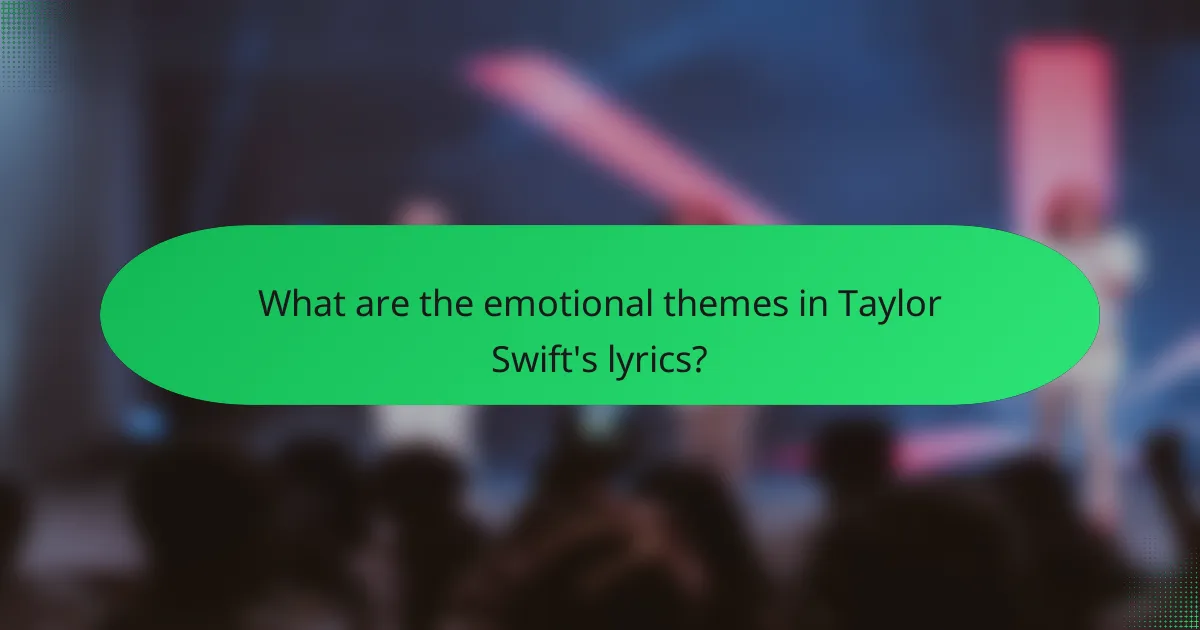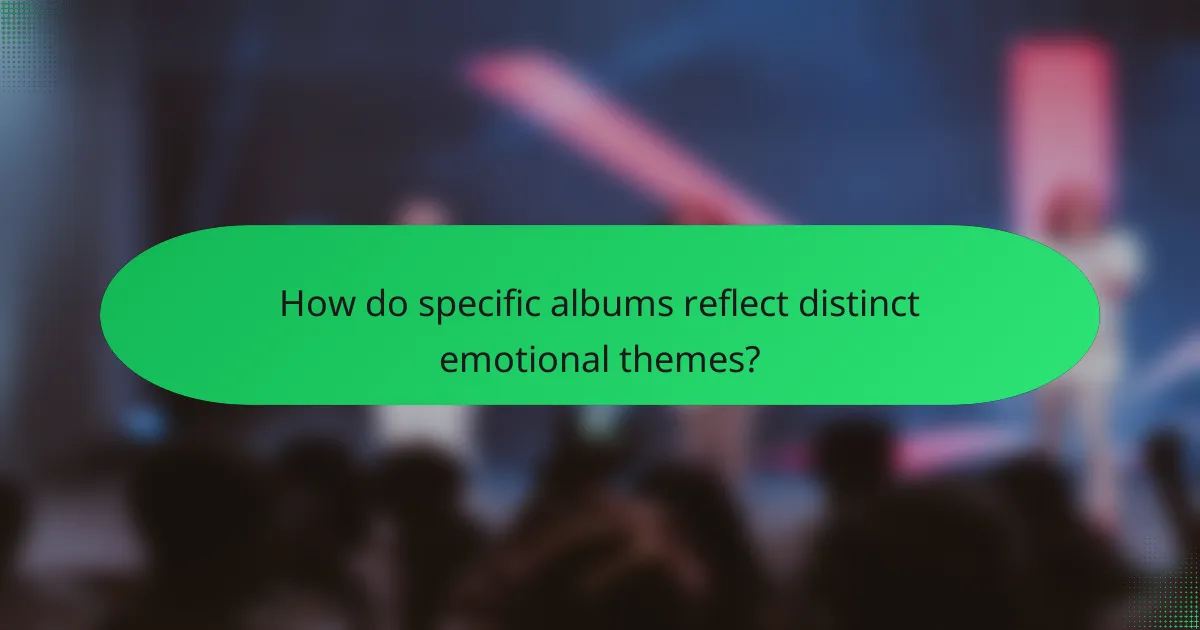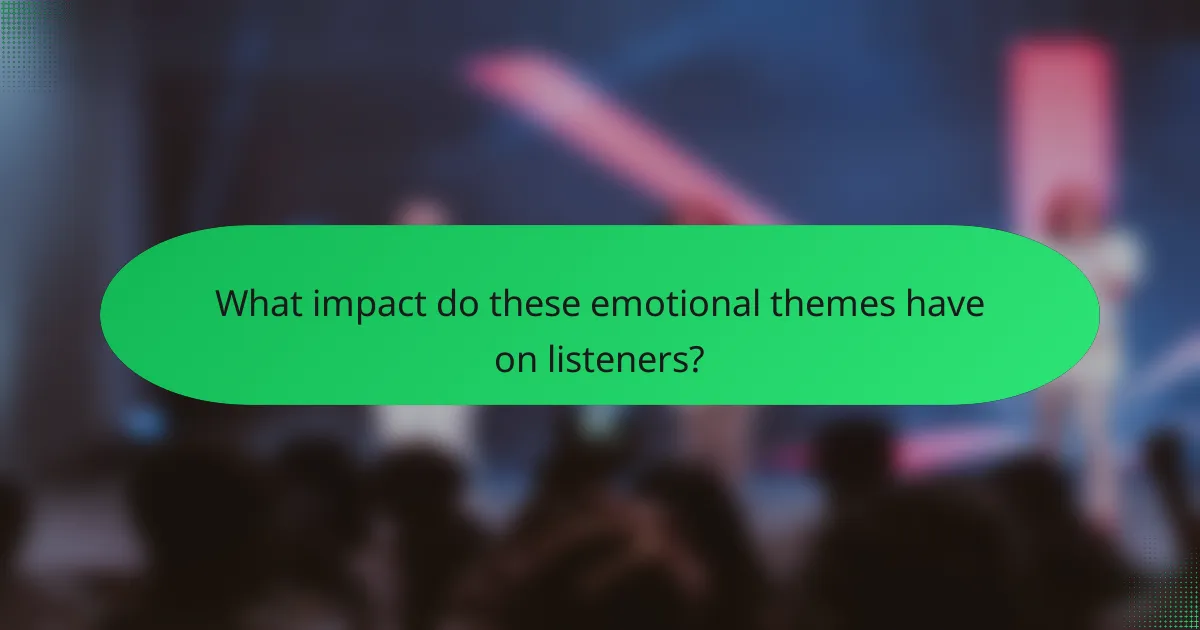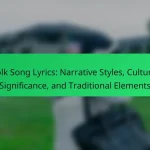Taylor Swift’s lyrics delve into emotional themes such as love, heartbreak, and self-discovery, resonating with a wide audience. Her albums, including “Fearless,” “Red,” and “Reputation,” reflect distinct emotional narratives through their lyrical content and musical composition. The exploration of themes like nostalgia, friendship, and resilience enhances the listener’s connection to her music. Research indicates that engaging with emotionally charged music can improve mood and foster emotional awareness, making Swift’s storytelling a source of solace for many. Overall, her work exemplifies the profound impact of emotional themes in music.

What are the emotional themes in Taylor Swift’s lyrics?
Taylor Swift’s lyrics explore various emotional themes, including love, heartbreak, and self-discovery. Love is often portrayed with both its joys and challenges. Heartbreak is a recurring theme, reflecting feelings of loss and longing. Self-discovery is evident in her journey of personal growth and empowerment. Other themes include nostalgia, friendship, and resilience. Swift’s storytelling connects deeply with listeners, making her music relatable. The emotional depth in her lyrics resonates across different audiences. This connection is evident in the widespread popularity of her songs.
How do Taylor Swift’s lyrics convey emotions?
Taylor Swift’s lyrics convey emotions through vivid storytelling and personal experiences. She often uses relatable scenarios to connect with listeners. Her use of metaphors and similes enhances emotional depth. Swift’s choice of words evokes specific feelings, making her songs resonate. For example, in “All Too Well,” she captures nostalgia and heartbreak with detailed imagery. The raw honesty in her writing allows listeners to feel her pain and joy. Additionally, her vocal delivery complements the emotional weight of her lyrics. This combination creates a powerful emotional experience for her audience.
What literary devices does Taylor Swift use to express emotions?
Taylor Swift uses various literary devices to express emotions in her lyrics. These include metaphors, similes, and imagery. Metaphors create vivid comparisons, enhancing emotional depth. For example, in “All Too Well,” she compares memories to a photograph. Similes, such as “like a dream,” clarify feelings by drawing relatable parallels. Imagery paints sensory experiences, allowing listeners to visualize emotions. In “Blank Space,” she describes love as a game, emphasizing its unpredictability. Additionally, personification gives human traits to abstract concepts, intensifying emotional resonance. These devices collectively enrich her storytelling and connect with audiences on a deeper level.
How do melodies and instrumentation enhance emotional delivery?
Melodies and instrumentation significantly enhance emotional delivery in music. Melodies create a specific mood through their structure and progression. For example, major keys often evoke happiness, while minor keys can evoke sadness. Instrumentation adds depth and texture to the emotional landscape. Different instruments can convey distinct feelings; for instance, strings may evoke nostalgia, while percussion can create urgency.
In Taylor Swift’s music, the combination of melodies and instrumentation is crucial. Her use of piano in ballads often emphasizes vulnerability. In contrast, upbeat tracks frequently incorporate guitars and drums to convey joy and empowerment. Research shows that music can trigger emotional responses due to its melodic contour and harmonic structure (Juslin & Västfjäll, 2008).
This interplay of melodies and instrumentation ensures that listeners connect emotionally with the lyrics and overall message.
What are the common emotional themes found in her discography?
Common emotional themes in Taylor Swift’s discography include love, heartbreak, and self-discovery. Her lyrics often explore the complexities of romantic relationships. Themes of nostalgia and reflection are prevalent in many songs. Swift frequently addresses personal growth and resilience. The theme of friendship also appears, highlighting its importance in her life. Additionally, she often touches on themes of fame and its impact on personal identity. These emotional themes resonate with listeners, showcasing her storytelling ability. Swift’s music captures a wide range of human experiences and emotions.
How does love and heartbreak manifest in her songs?
Love and heartbreak manifest in Taylor Swift’s songs through vivid storytelling and emotional lyrics. She often uses personal experiences as the basis for her songs. Swift’s lyrics explore the complexities of love, from infatuation to deep sorrow. Her songs frequently feature relatable themes of longing and loss. For example, “All Too Well” captures the pain of remembering a past relationship. The imagery in her lyrics evokes strong emotions, allowing listeners to connect deeply. Swift’s use of metaphor and simile enhances the emotional impact of her music. Additionally, she employs various musical styles to reflect the intensity of her feelings. This combination of lyrical depth and musicality makes her exploration of love and heartbreak resonate with many fans.
What role does nostalgia play in her lyrics?
Nostalgia plays a significant role in Taylor Swift’s lyrics. It often evokes memories of past relationships and experiences. Her songs frequently reflect on childhood, lost love, and formative moments. This nostalgic element creates emotional depth and relatability. For instance, tracks like “The Best Day” and “Fifteen” highlight her longing for simpler times. The use of vivid imagery enhances the listener’s connection to these memories. Swift’s storytelling often intertwines personal history with universal themes. This technique resonates with a wide audience, making her music impactful.
How does Taylor Swift address themes of identity and self-discovery?
Taylor Swift addresses themes of identity and self-discovery through her lyrics and storytelling. Her songs often reflect personal experiences and evolving perspectives. For instance, in “The Archer,” she explores vulnerability and the search for self-acceptance. The lyrics reveal her introspection about past relationships and personal growth. Additionally, “Clean” symbolizes overcoming struggles and finding clarity after turmoil. Swift’s narrative style allows listeners to connect with her journey of self-exploration. Her discography showcases a transformation from teenage angst to [censured] reflection, illustrating her evolving identity. Through these themes, she resonates with audiences navigating their own journeys of self-discovery.

How do specific albums reflect distinct emotional themes?
Specific albums reflect distinct emotional themes through their lyrical content and musical composition. Taylor Swift’s albums often explore varied emotions such as love, heartbreak, and self-discovery. For example, “Fearless” embodies youthful optimism and romantic excitement. In contrast, “Red” delves into the complexities of heartbreak and nostalgia. “Reputation” expresses themes of betrayal and resilience in the face of public scrutiny. Each album’s production style also enhances its emotional tone. The instrumentation and arrangement contribute to the overall mood. Lyrical storytelling allows listeners to connect with the emotions conveyed in each song. This connection is evident in fan interpretations and critical analyses of her work.
What emotional themes are prominent in ‘Fearless’?
The prominent emotional themes in ‘Fearless’ include love, vulnerability, and courage. The song expresses the exhilaration of young love. It captures the feeling of being fearless in the face of romantic challenges. Vulnerability is evident as the narrator opens up about her feelings. The lyrics convey a sense of hope and optimism. The imagery used evokes a sense of nostalgia and longing. Courage is highlighted through the willingness to embrace love despite uncertainties. Overall, ‘Fearless’ resonates with themes of emotional strength and youthful passion.
How does ‘Fearless’ portray youthful love and optimism?
‘Fearless’ portrays youthful love and optimism through its vivid imagery and relatable themes. The lyrics express a sense of adventure and spontaneity associated with young love. Phrases like “dancing in a storm in my best dress” highlight the joy and excitement of romantic moments. The song captures the feeling of being fearless in love, suggesting that youth is characterized by hope and courage. It emphasizes the idea that love can be pure and exhilarating, free from the burdens of [censured] life. This portrayal resonates with listeners, evoking nostalgia and a longing for carefree experiences. The overall tone of the song reinforces the belief that youthful love is both magical and transformative.
What emotional conflicts are present in ‘Fearless’?
‘Fearless’ presents emotional conflicts such as vulnerability versus bravery and love versus fear. The protagonist grapples with the excitement of new love while fearing potential heartbreak. This duality creates tension throughout the song. Lyrics convey a sense of exhilaration mixed with anxiety. The imagery of dancing in the rain symbolizes joy intertwined with uncertainty. Additionally, the conflict between idealism and realism is evident. The character balances dreams of a perfect relationship against the reality of emotional risks. These conflicts enhance the song’s depth and relatability.
What emotional narratives are explored in ‘Red’?
The emotional narratives explored in ‘Red’ include love, heartbreak, nostalgia, and longing. The song captures the intensity of passionate relationships. It reflects on the bittersweet memories tied to love. Themes of loss and yearning are prominent throughout the lyrics. The contrast between joy and pain is vividly portrayed. Imagery of colors symbolizes different emotional states. The narrative evokes a sense of vulnerability and raw emotion. Overall, ‘Red’ encapsulates the complexities of love and its aftermath.
How does ‘Red’ depict the complexities of love and loss?
The song “Red” by Taylor Swift portrays the complexities of love and loss through vivid imagery and emotional contrasts. It uses colors to symbolize intense emotions, with red representing passionate love and deep heartache. The lyrics describe love as exhilarating yet painful, highlighting the duality of joy and sorrow. Swift contrasts memories of love with the pain of its absence, emphasizing how love can leave lasting scars. The phrase “loving him is like driving a new Maserati down a dead-end street” illustrates the thrill and inevitable heartbreak. The song captures the bittersweet nature of relationships, showcasing the intertwining of happiness and grief. Through these elements, “Red” effectively conveys the intricate emotions associated with love and loss.
What unique emotional expressions are found in ‘Red’ compared to other albums?
The unique emotional expressions found in ‘Red’ include heightened feelings of heartbreak and nostalgia. This album showcases a blend of intense love and loss, often reflecting on past relationships. The lyrics convey vulnerability and raw emotion, presenting a more mature perspective on love. Songs like “All Too Well” illustrate vivid memories and emotional turmoil. The use of metaphors enhances the depth of these feelings. Compared to her earlier works, ‘Red’ emphasizes complexity in emotional experiences. The album’s production also complements these themes with a mix of pop and country elements. Overall, ‘Red’ stands out for its emotional intensity and lyrical storytelling.
How does ‘Folklore’ introduce new emotional dimensions?
‘Folklore’ introduces new emotional dimensions through its introspective storytelling and nuanced character development. The album explores themes of nostalgia, longing, and heartbreak in a more subtle manner than previous works. Each song presents a unique narrative perspective, allowing listeners to connect with varied emotions. For instance, “The 1” reflects on lost love with a sense of wistfulness. In contrast, “Exile” delves into feelings of betrayal and regret through a duet format. The use of metaphor and imagery in tracks like “Cardigan” evokes deep emotional responses. Additionally, the collaboration with Aaron Dessner and Bon Iver brings a fresh sonic landscape that enhances the emotional weight of the lyrics. This blend of storytelling and sound creates a multifaceted emotional experience, distinguishing ‘Folklore’ from Taylor Swift’s earlier albums.
What storytelling techniques contribute to the emotional depth of ‘Folklore’?
The storytelling techniques that contribute to the emotional depth of ‘Folklore’ include vivid imagery, character-driven narratives, and introspective lyrics. Vivid imagery allows listeners to visualize scenes and emotions. This technique creates a strong connection to the feelings conveyed in the songs. Character-driven narratives immerse the audience in the lives of distinct characters. Each character’s experiences evoke empathy and understanding. Introspective lyrics reflect personal thoughts and emotions, enhancing relatability. These elements work together to create a rich emotional landscape. Taylor Swift’s use of these techniques has been noted in various reviews and analyses of the album. Critics highlight how they deepen the listener’s emotional engagement with the music.
How do the themes of isolation and reflection manifest in ‘Folklore’?
The themes of isolation and reflection manifest in Taylor Swift’s ‘Folklore’ through its introspective lyrics and storytelling. The album captures feelings of solitude in various narratives. Songs like “The 1” and “Epiphany” express a sense of longing and contemplation. The use of imagery often evokes a quiet, reflective state. For instance, the lyrics frequently reference nature, enhancing the sense of isolation. Additionally, the storytelling approach allows for deep character exploration, revealing inner thoughts. This narrative style fosters a connection between the listener and the themes of introspection. Overall, ‘Folklore’ effectively intertwines isolation and reflection within its emotional landscape.

What impact do these emotional themes have on listeners?
Emotional themes in Taylor Swift’s lyrics significantly impact listeners by fostering connection and resonance. These themes evoke feelings of nostalgia, joy, and heartbreak. They allow listeners to relate their personal experiences to the narratives presented in the songs. Research indicates that music with emotional content can enhance mood and provide comfort during difficult times. A study published in the Journal of Positive Psychology found that engaging with emotionally charged music can lead to increased emotional awareness and expression. This connection is particularly strong in Taylor Swift’s work, where her storytelling mirrors listeners’ own life experiences. As a result, her lyrics often serve as a source of solace and understanding for many.
How do Taylor Swift’s lyrics resonate with fans on a personal level?
Taylor Swift’s lyrics resonate with fans on a personal level by reflecting relatable emotions and experiences. Her songwriting often explores themes of love, heartbreak, and self-discovery. Fans connect with her narratives about relationships and personal growth. Specific songs, like “All Too Well,” evoke vivid memories and feelings. Swift’s use of detailed storytelling creates a sense of intimacy. Research shows that music with emotional depth can enhance listener connection. A study by the University of California found that lyrics expressing personal experiences foster strong emotional responses. This connection is evident in fan interactions and social media discussions about her music.
What psychological effects do her emotional themes have on listeners?
Taylor Swift’s emotional themes evoke a range of psychological effects on listeners. Her lyrics often resonate with feelings of nostalgia, love, and heartbreak. This connection can lead to emotional catharsis, allowing listeners to process their own experiences. Research indicates that music can enhance mood and provide comfort during difficult times. A study published in the Journal of Music Therapy found that music with relatable themes can reduce feelings of loneliness. Swift’s storytelling often fosters a sense of belonging among her audience. This shared emotional experience can strengthen listener identity and community. Overall, her emotional themes significantly impact listeners’ mental well-being.
How does fan interpretation shape the understanding of her emotional themes?
Fan interpretation significantly shapes the understanding of Taylor Swift’s emotional themes. Fans often analyze her lyrics through personal experiences and cultural contexts. This analysis creates diverse interpretations of her songs. For example, themes of heartbreak and empowerment resonate differently with various audiences. Fans may connect specific lyrics to their own life events. This personal connection enhances the emotional depth of her music. Additionally, fan discussions on social media amplify these interpretations. These conversations can shift public perception and understanding of her themes. Ultimately, fan interpretation enriches the overall narrative of her work.
What are some practical takeaways from Taylor Swift’s emotional themes?
Taylor Swift’s emotional themes emphasize self-reflection and personal growth. Her lyrics often explore heartbreak, resilience, and the complexities of relationships. Listeners can learn the importance of processing emotions through her storytelling. Swift’s music encourages vulnerability, suggesting that sharing feelings can lead to healing. She illustrates the significance of moving on after difficult experiences. Her themes promote empathy, inviting listeners to connect with their own struggles. Additionally, Swift highlights the value of authenticity in expressing one’s true self. Overall, her emotional themes serve as a guide for navigating life’s ups and downs.
How can listeners use her lyrics for personal reflection and growth?
Listeners can use Taylor Swift’s lyrics for personal reflection and growth by relating her experiences to their own lives. The themes in her songs often address love, heartbreak, and self-discovery. This relatability allows listeners to examine their own emotions and situations. For instance, her song “All Too Well” captures the complexities of past relationships. By engaging with such narratives, listeners can process their feelings and gain insights into their own experiences. Research indicates that music can evoke emotional responses that facilitate personal reflection. A study by the University of Groningen found that lyrics can enhance emotional understanding and self-awareness. Therefore, Taylor Swift’s lyrics serve as a tool for listeners to explore their emotions and foster personal growth.
What lessons about emotions can be learned from her songwriting?
Taylor Swift’s songwriting teaches that emotions are complex and multifaceted. She explores themes of love, heartbreak, and self-discovery. Her lyrics often reflect vulnerability and authenticity. This connection resonates with listeners, illustrating shared human experiences. Swift’s storytelling showcases the importance of expressing feelings. She emphasizes growth through emotional pain. Her songs demonstrate that healing is a journey. Overall, her work encourages embracing emotions as part of life.
The primary entity of this article is the emotional themes present in Taylor Swift’s lyrics. The article examines various emotional themes such as love, heartbreak, self-discovery, nostalgia, and resilience, highlighting how these themes resonate with listeners. It discusses the literary devices Swift employs, including metaphors and imagery, to convey emotions effectively. Additionally, the article explores how melodies and instrumentation enhance the emotional delivery of her songs, along with the impact these themes have on listeners’ psychological well-being and personal growth. Overall, it provides a comprehensive analysis of how Swift’s storytelling connects with audiences on a personal level.


